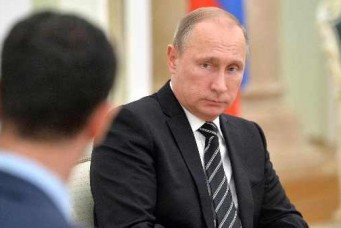Russia’s Long-Term Aims in Syria
Russia hopes its recent military support to Bashar Al-Assad will give it political leverage over the Syrian regime and counter Western military might both in Syria and globally.
In response to the media hype accompanying its recent military intervention in Syria, Moscow has once again reverted to talk of protecting the Syrian state and religious minorities against terrorism and foreign-backed jihadi groups. In his recent speech at the United Nations General Assembly, President Vladimir Putin of Russia defended Russia’s military role in Syria as an obligation to fight the Islamic State that “was initially forged as a tool against undesirable secular regimes” and is now “seeking dominance in the Islamic world.” Two days after Putin’s speech, Russia launched its first air strikes in Syria, which the Russian Orthodox Church called a “holy battle” that recalls the suffering of Christians in the region.
In the same vein, Moscow has been stressing that it is not committed to preserving Syrian President Bashar Al-Assad, but rather its recent strikes were an attempt to “avoid total disaster in Syria.” But Moscow has a vested interest in keeping Assad in power, and establishing a primary military presence in Syria gives it a foothold to rescue the Syrian regime if or when it faces the risk of collapse.
Furthermore, Russia’s military presence in Syria also serves long-term objectives related to its own expansionary military doctrine. Recent air strikes come as Moscow moves away from the “conservative” military doctrine that prevailed after the collapse of the Soviet Union, when Russia reduced its defense budget from 30 percent of GDP to about 4.5 percent. Putin began wide-ranging reforms to strengthen Russian military capabilities, including a $283 billion project to modernize the army’s military hardware. Just two months ago, Russia also amended its naval military doctrine to prioritize confronting NATO. This prompted it to preserve a permanent presence for its fleets in the Atlantic Ocean and the Mediterranean Sea, where the Syrian cities of Tartus and Latakia are its only outlets. In this sense, the military expansion in Syria is part of a bigger Russian expansion that includes establishing military bases in several countries, including Vietnam, Cuba, Venezuela, Nicaragua, Seychelles, Singapore, and Belarus.
Russia does not conceal its tendency to challenge what it describes as Western attempts to “dominate global affairs,” most recently in Syria and Ukraine. The new Russian military action in Syria is partly a response to its exclusion from the U.S.-led international coalition to fight the Islamic State (IS). This motivated Moscow to establish its own anti-IS alliance within the region of Syria under the regime’s control, opposed to the “illegal” alliance that is built on “false foundations” because it excludes Assad. After it failed to bring neighboring countries—in particular Turkey, Saudi Arabia, and Qatar—together in a single alliance with Iran and the Syrian regime to confront the Islamic State, Russia has begun to send military reinforcements to Syria on its own. It quickly went further, appearing to target the “moderate” rebel groups in Syria, including the U.S.-backed Free Syrian Army, despite claims that all airstrikes are against the Islamic State.
The Russian military presence in Syria can also help it strengthen the countries’ current modest economic ties and establish long-term ones. Although Damascus has always had good political relations with Moscow, trade between the two only became significant after the outbreak of protests in 2011. According to official Syrian figures, trade between Russia and Syria amounted to about $1 billion in 2010, yet it rose to about $2 billion in 2011. Even though the fierce war raging in Syria has obstructed further commercial trade, both countries desire stronger economic relations. For example, in April the two sides officially announced plans to open agricultural trade through Tartus and Latakia.
In July, the Russian Union of Gas and Oil Industrialists also announced that after “the situation becomes stable” in Syria it seeks to invest at least $1.6 billion into energy contracts. In 2013, the Syrian government signed a twenty-five-year contract with the Russian Soyuzneftegaz company for oil and gas drilling and exploration in an area off the Syrian coast. It seems the Russians are serious about following up on such energy contracts, as evidenced by the mid-September visit of a Russian delegation of experts in the fields of oil and electricity to Damascus. For his part, Syrian Minister of Petroleum Suleiman Al-Abbas promised this delegation that “Russian companies will have a major role in the investment opportunities available in the future.”
Russia—a country that relies heavily on the export of natural gas—is well aware of the importance of Syria’s location as a possible site for a network of oil and gas pipelines to Turkey and then Europe. This threatens Russia’s own hegemony over the export of gas to the European continent (Russia’s share of total European gas imports exceeds 64 percent). Russia seems to be rushing towards investing in Syria’s energy sector because it would rather have a share in its energy development than compete with it.
Russia may be hoping that its military presence and economic projects in Syria will increase the Syrian regime’s dependency on Moscow, which would have greater influence on the regime’s political and military decisions. Several incidents suggest that the Assad regime—while closely coordinating military and diplomatic moves with Russia—has not fully submitted to Russia’s vision on the conflict and rejected a number of Moscow’s political demands. The Syrian regime undermined Moscow’sefforts to form a national unity government in Syria by indicating their unwillingness and persecuting all opposition—even the internal opposition that called for dialogue with the Syrian government and maintained close ties with Russia. In April, the Syrian regime obstructed the Moscow 1 and Moscow 2 conferences, which Russia organized to include the “constructive opposition” (the Syria-based opposition that does not demand Assad’s departure), by banning some of the invited opposition members from leaving the country.
Assad’s ability to obstruct these initiatives shows how weak Russian influence is within the agencies of the Syrian regime. If it wants to be able to play a role in the Syrian conflict, Moscow believes its only choice is to support Assad militarily and forgo political solutions, which the Syrian regime has excelled at thwarting. The Syrian regime, suffering successive military defeats, is losing its ability to maintain centralized control since the number of local and foreign pro-regime militias that operate outside the framework of the Syrian army has increased. In light of this military vulnerability, Russia hopes that increasing its military influence in Syria will give it the political leverage to get Assad to make genuine concessions in negotiations with the United States and regional countries—and ultimately reach a settlement that can fully safeguard Russian interests in Syria. This could allow it to exploit newfound U.S flexibility on the fate of Assad, but only if it can deliver on U.S. Secretary of State John Kerry’s most important question: “We’re prepared to negotiate… Is Russia prepared to bring [Assad] to the table and actually find the solution to this violence?”
This article was translated from Arabic. It is reprinted with permission from Sada and can be accessed online here.
Salam Al-Saadi is a Palestinian-Syrian journalist and researcher focused on political and economic affairs in the Middle East, particularly in Syria.
Subscribe to Our Newsletter





